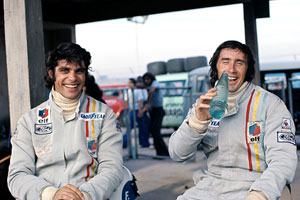Columns -
Champions Forever

BY MAURICE HAMILTON
<script src="http://connect.facebook.net/en_US/all.js#xfbml=1"></script><fb:like href="http://www.grandprix.com/columns/maurice-hamilton/champions-forever.html" layout="box_count"></fb:like></p> <p>Apparently, nostalgia can be classified as a medical condition. In which case, I picked up the virus the other day when someone sent me a link to a wonderful Formula 1 film made by Colombia Pictures in 1973. If you need reminding how F1 has changed - mainly for the better - then this evocative piece of work will do the trick.</p> <p>Entitled 'Champions Forever', the film was shot at Monaco (of course!), Interlagos, Montjuich Park, Anderstorp, Zolder, Paul Ricard, Silverstone, Nurburgring Nordschleife, Monza and Watkins Glen. And that's the first thing that hits you. </p> <p>Although the narrative does not actually say 'This is Belgium's Zolder race track...' or 'And here at Anderstorp in Sweden...', you recognise each circuit instantly because of its unique characteristics. (Unlike a very smart F1 2011 calendar I recently received and on which it's desperately difficult to distinguish Shanghai from Sepang or close-ups of Sakhir.)</p> <div class="wsw-Photo" style="width: 300px"><a href="http://www.grandprix.com/jpeg/phc/mh/12/1974-southafrica-hailwood1-lg.jpg"><img height="450" width="300" src="http://www.grandprix.com/jpeg/phc/mh/12/1974-southafrica-hailwood1-rg.jpg" alt="Mike Hailwood, South African GP 1974" /></a><p class="photocaption">Mike Hailwood, South African GP 1974 </p><p class="photocredit"> © The Cahier Archive</p></div> <p>The film does not tell the story of 1973. Rather, it sets out to explain what F1 is all about - and this it does remarkably well thanks to a tight script read with excellent and suitably dramatic effect by the actor, Stacy Keach. </p> <p>But much of the depth is provided by relaxed interviews with Francois Cevert, Mike Hailwood and Peter Revson. These clips are heightened by their rarity value because, tragically, Cevert and Revson were killed within 12 months and Hailwood died in a road accident in 1981.</p> <p>I had met Hailwood but, despite being within gawping range as a fan of Cevert and Revson, I had never heard either of them speak at length. The thing that comes across immediately is the intelligence and articulation of all three as they explain why they went racing. That may seem an obvious topic but you have to remember that this was 1973, a time when the sport's hazards inflicted infinitely more appalling results than they do now.</p> <p>There is a reminder of this as Hailwood - with typical reluctance - talks about how he waded into Clay Regazzoni's blazing BRM and helped pull the semi-conscious Swiss driver clear - and this after Hailwood had already been forced to retreat temporarily because his gloves and overalls were well and truly alight.</p> <p>Because the producers did not need to rely on TV footage, there are many clips and angles I had never seen before. There is an on-board ride as Niki Lauda wrestles his BRM around the awesome Montjuich Park. Or a trackside view of the carnage at Silverstone when Jody Scheckter lost control at the end of the first lap of the 1973 British Grand Prix. </p> <p>I sat with my Dad in the Woodcote grandstand that day and watched with mounting horror as, away to our left, Scheckter tapped the pit wall nose-first before rolling slowly backwards to trigger the mayhem as the second half of the field powered through Woodcote.</p> <div class="wsw-Photo" style="width: 300px"><a href="http://www.grandprix.com/jpeg/phc/mh/12/1973-britain-start1-lg.jpg"><img height="200" width="300" src="http://www.grandprix.com/jpeg/phc/mh/12/1973-britain-start1-rg.jpg" alt="Start, British GP 1973" /></a><p class="photocaption">Start, British GP 1973 </p><p class="photocredit"> © The Cahier Archive</p></div> <p> I'd have sworn blind that Jody simply got sideways after putting a wheel on the dirt at the exit and then headed towards the pit wall. The film shows clearly that, after putting his left-rear on the dirt, Scheckter spun through a full 360 degrees before touching the wall and then finding himself parked sideways in front of the charging mob. </p> <p>Jackie Stewart was leading the race at the time and, this being his third and final championship year, the Scot features strongly in the film. There is some wonderful narrative, particularly as Stewart drives an open-top Rolls Royce around the Nurburgring and explains the awesome nature of the 14-mile beast. At one point, his words form the backdrop to a really stunning long-range shot of Stewart and Cevert riding the crests of the Tiergarten Straight as the pair of blue Tyrrells, ungainly by today's standards and clearly a bit of a handful at this place, lead the race by miles.</p> <p>There are other moments - an everyday occurrence in 1973 but bizarre now - such as seeing Stewart preparing for action with his gloves and helmet resting on a fold-up picnic chair in the Tyrrell garage. And not a manager, physio, engineer or PR person in sight.</p> <div class="wsw-Photo" style="width: 300px"><a href="http://www.grandprix.com/jpeg/phc/mh/12/1973-britain-revson1-lg.jpg"><img height="450" width="300" src="http://www.grandprix.com/jpeg/phc/mh/12/1973-britain-revson1-rg.jpg" alt="Peter Revson, British GP 1973" /></a><p class="photocaption">Peter Revson, British GP 1973 </p><p class="photocredit"> © The Cahier Archive</p></div> <p>As for the cars themselves: if you're a modern-day aerodynamicist, then look away now. It is the simplicity of the machinery in this pre-carbon fibre and wind tunnel age that smacks you between the eyes, many of the cars having the ubiquitous Ford-Cosworth DFV bolted on the back with fresh air all around the V8 and an airbox held on by clips.</p> <p>The version of the film I watched ends prematurely - which is perhaps just as well as it was probably building up to Cevert's tragic accident at Watkins Glen. </p> <p>The pathos had already been applied when the Frenchman, asked about what he had learned from racing alongside Stewart, said this: "Jackie can do a whole race without making a mistake. I can only do one lap as fast as Jackie. What does this mean? It means I must not make any mistakes."</p> <p>He made one that afternoon at The Glen. Being 1973 and not 2011, the consequences were terrible. This may have been a more glamorous and carefree era with cars that were as tricky to drive as they were spectacular to watch, but the price paid by Cevert and others helps remove the rose-tint from your favourite nostalgia glasses.</p> <p>Link: <a href="http://vimeo.com/17632646">'Champions Forever'</a></p> <p>Link: <a href="http://www.grandprix.com/gpe/raceresults1973.html">Grandprix Encyclopedia, 1973 season</a>